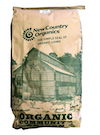

Getting chicks for the first time is a very exciting experience. While chicks are cute and are certainly a great segue into other avenues of agriculture, they can be a handful for first time owners. This guide will answer the questions you may have when getting your new chicks this spring! Here are a couple of things you will need prior to the chicks' arrival:
A place to call their own
You can use anything from a box, aquarium (without the water, of course!), or brooder panels specifically made for raising chicks. Sheets of newspaper can be used to line the chick area, but it is best to also use hemp bedding, as the newspaper does not provide enough traction or support for chicks' feet. Hemp bedding is very absorbent and is a less dusty alternative to typical animal bedding options. Space is also important, as chicks love to play and need sufficient space to do so for their development.
A quality heat source
This is also needed to keep the chicks warm until their adult feathers grow in at approximately 5 to 8 weeks of age. We recommend heat plates over heat lamps. Chicks huddle underneath the plate, which mimics the presence and warmth of a mother hen. The temperature of a heat plate is more easily controlled than that of a heat lamp, and the plates can be raised as the chicks grow in height. Whatever heating method is used, ensure that adequate ventilation is provided to minimize fire risk but maintain proper temperature.
A fresh, consistent supply of water
Water is often the most forgotten nutrient in livestock operations, but it is critical to every function of the body. Traditional chicken waterers are easily contaminated when chicken droppings fall into the base of the waterers, potentially leading to disease if not cleaned consistently. Chicks and adult poultry can easily be trained to use a nipple watering system, leading to much less headache in management. When you first introduce your chicks to their new environment, you can add 3 tablespoons of sugar per quart of water or 1 crushed clove of garlic in order to entice them to drink. Whether using a traditional watering system or a BriteTap/equivalent nipple watering system, gently dip the beaks of the chicks in the watering source to teach them to drink. Change and clean the water source daily. To keep possible dampness from occurring, you can place a small towel underneath your waterer to absorb any spillage. Replace this towel every day to prevent pathogen build up.
A quality feed source
We recommend using an enclosed feeder with holes big enough for the chicks to peck through the open slots. The slots are big enough for the chicks to reach the feed, but generally small enough to prevent feed contamination from fecal droppings. The feeder should be kept full, as it is generally recommended to feed free-choice for the first few weeks of life. When you introduce your chicks to their new environment, dip their beaks into the feed to teach them the location of the feeder and encourage them to eat.
Organic feeds fortified with probiotics and vitamins and minerals are the perfect way to ensure the health of your birds. We recommend feeding New Country Organics Starter Feed for the first 4 full weeks of life. When the birds are 5 weeks old, we recommend that they be transitioned to New Country Organics Grower/Broiler Feed and kept on it until slaughter or until they are 16 weeks of age. After 16 weeks of age or when the first egg appears, we recommend transitioning to New Country Organics Layer Feed, which is the last transition. At this point, your birds are fully grown!
Grit
Grit is stored in the gizzard, which is the part of the digestive tract that mechanically breaks down the food and aids in the grinding of food particles. We recommend providing free choice Starter Grit for the first several weeks of life and Layer Grit for adult birds. Oyster shell can be used for adult hens as both an added calcium source and a source of grit. It is generally provided free-choice so that hens can self-regulate their calcium intake according to their individual needs.
When should I move my chicks to their coop?
Deciding when to move your chicks to an outdoor coop and environment can depend on several factors. First and foremost is outside temperature. If temperatures are below 65 degrees and your outdoor coop does not have a heat source, it is best to wait until outside temperatures reach at least 60 to 65 degrees before transitioning your chicks. Second is feather thickness. Your chicks should be fully feathered by 6 weeks of age, which indicates that they are prepared for an outdoor transition. This varies by breed, so it is important to evaluate each breed separately. Third is the predator proofness of your coop area, as the chicks are still at a vulnerable age. For the first few nights, it is important to keep the chicks inside the coop to acclimate them to their new environment. After this period, the chicks may be allowed to free range inside their chicken run or your designated chicken area. Once you have reached this point, you have succeeded at raising chicks to adulthood!
Please remember that there are bacteria associated with poultry that you may not be familiar with as a new poultry parent. Always wash your hands after handling your chicks or working in their living area. As tempting as it may be, use caution when cuddling with your new babies; we recommend not kissing or bringing your chicks near your face because they may be carrying germs even if they look clean and display no signs of illness.
Have questions? Drop us a line. We are here to help!










